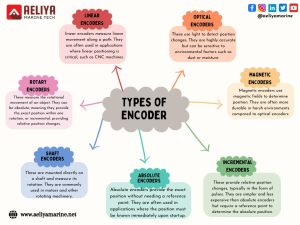What is an Encoder?
At its core, an encoder is a device that converts motion into an electronic signal. This signal can then be read by a control system, such as a programmable logic controller (PLC), to determine parameters like position, speed, or direction. Encoders essentially act as translators, providing critical feedback that allows systems to function accurately and efficiently.
For example, in a conveyor belt system, an encoder can monitor the belt’s speed and position, ensuring that products are correctly aligned and spaced. Similarly, in robotics, encoders provide the precise positioning data necessary for intricate movements.
Types of Encoders
Encoders come in various types, each suited to specific applications and operating conditions. Here’s a look at the most common types:
1. Rotary Encoders
Rotary encoders measure rotational motion, such as the angle of a rotating shaft. They are widely used in motors, robotics, and CNC machines.
- Incremental Rotary Encoders: These encoders provide relative position feedback, generating pulses as the shaft rotates. The control system interprets these pulses to calculate position, speed, or direction.
- Absolute Rotary Encoders: These encoders provide unique position values from the moment they are powered on, making them ideal for applications requiring exact positioning, even after a power cycle.
2. Linear Encoders
Linear encoders measure straight-line motion, commonly found in precision tools like measuring instruments and advanced manufacturing equipment.
- Magnetic Linear Encoders: Use magnetic fields to detect motion and are often employed in harsh industrial environments due to their durability.
- Optical Linear Encoders: Use light patterns to measure motion with high precision and are commonly used in labs and high-end machinery.
3. Optical Encoders
Optical encoders rely on a light source and a photodetector to read patterns on a disc or strip. These are highly accurate and are frequently used in high-precision applications.
4. Magnetic Encoders
Magnetic encoders use magnetic fields to measure motion. They are robust and well-suited for challenging environments, such as those with dust, vibration, or temperature fluctuations.
5. Capacitive Encoders
Capacitive encoders use electrical capacitance to determine motion. These are typically smaller, lightweight, and more cost-effective.
Key Features of Encoders
Encoders are packed with features that make them indispensable in industrial and commercial applications:
- Precision: Encoders provide highly accurate feedback, essential for tasks requiring exact movements or measurements.
- Durability: Many encoders are designed to withstand harsh environments, including exposure to dust, water, and extreme temperatures.
- Versatility: Encoders can measure various parameters, such as position, speed, and direction, making them useful in diverse fields.
- Compact Design: Despite their capabilities, encoders are often compact, allowing them to be integrated into space-constrained systems.
Applications of Encoders
Encoders are used across a vast array of industries, enabling the seamless functioning of countless systems:
1. Automation and Robotics
Encoders provide feedback for positioning and motion control in robotic arms, ensuring smooth and precise movements.
2. Industrial Machinery
From CNC machines to textile manufacturing, encoders ensure accurate control and synchronization of machinery.
3. Elevators and Escalators
Encoders track the position and speed of elevators and escalators, ensuring safety and smooth operation.
4. Medical Equipment
In devices like MRI machines and surgical robots, encoders provide the precision necessary for critical healthcare applications.
5. Automotive Industry
Encoders are integral to systems like anti-lock braking, adaptive cruise control, and electric power steering.
6. Renewable Energy
Encoders are used in wind turbines to monitor the blade position and optimize energy generation.
Choosing the Right Encoder
Selecting the right encoder depends on several factors:
- Application Requirements: Determine the type of motion (rotary or linear) and the parameters to measure (position, speed, direction).
- Environmental Conditions: Consider factors like temperature, humidity, and exposure to dust or vibration.
- Resolution: Choose an encoder with the appropriate resolution for your application. Higher resolution means greater accuracy.
- Output Type: Decide between digital or analog output based on your control system’s compatibility.
- Budget: Balance performance requirements with cost considerations.
The Future of Encoders
As technology advances, encoders are becoming smarter and more versatile. Innovations like wireless encoders, integration with IoT systems, and enhanced durability are expanding their capabilities. These developments are paving the way for even greater efficiency and precision in automation and control systems.

